Disclosure: Privacy Australia is community-supported. We may earn a commission when you buy a VPN through one of our links. Learn more.
Top 8 LICs on the ASX for 2024: A Comprehensive Guide
Investing is not just making money. It’s a process that requires careful moves and in-depth knowledge. It’s important to not only choose a broker based on personal preferences, but to look carefully at features and reputation. A way to do that is to make sure it is listed on the Australian Securities Exchange, or ASX for short.
Listed Investment Companies, also known as LICs, are a good way to diversify our portfolios and mitigate risk. However, if they’re listed on the ASX, it’s an even bigger advantage.
To help us understand which are the best ASX-listed LICs, I’ve put together this comprehensive guide. Together, we’ll dive deep into each company’s pros and cons, and identify which are the best.
TL;DR
- Australian Foundation Investment Company (AFI) offers stability and consistent fully franked dividends.
- Argo Investments (ARG) provides a diversified portfolio with low costs.
- WAM Capital (WAM) focuses on active management in small-mid cap space.
- MCP Master Income Trust (MXT) offers exposure to the corporate loan market.
- BKI Investment Company (BKI) emphasises companies with strong dividend histories.
- Tribeca Global Natural Resources Limited (TGF) specialises in the global natural resources sector.
- Platinum Asset Management (PTM) employs a contrarian global investing approach.
- Forager Australian Shares Fund (FOR) focuses on value investing in Australian small-mid caps.
Criteria Breakdown Summary
To help us evaluate these ASX-listed LICs, I put together a list of criteria. I assessed investment strategy, performance history, and management fees first. Then, I looked at the discount or premium to Net Asset Value, to work out the cost-effectiveness of each LIC. I rated all of my chosen companies out of five, to help us see a broader picture.
1. Australian Foundation Investment Company (AFI)
Best Known for: Stability and Consistent Dividends
The first LIC I looked at was the Australian Foundation Investment Company, or AFI for short. This is a very reputable option with a long history dating back to 1928. The plus point of AFI is that they constantly look for reliable companies that bring long-term reliability. They’re not about chasing the latest fad. Of course, this is ideal because it means stronger dividends over time.
For me, AFI is a solid investment but it’s not an exciting one, focusing on long-term Australian and New Zealand equities. It will bring steady fully-franked revenue but it won’t surprise me with huge gains overnight. However, I’m not looking for extremely risky investments, so that works well for me. I could say it’s a boring investment option, but sometimes boring works better. Out of all the LICs, at least I know that by using AFI, I can sleep soundly at night.
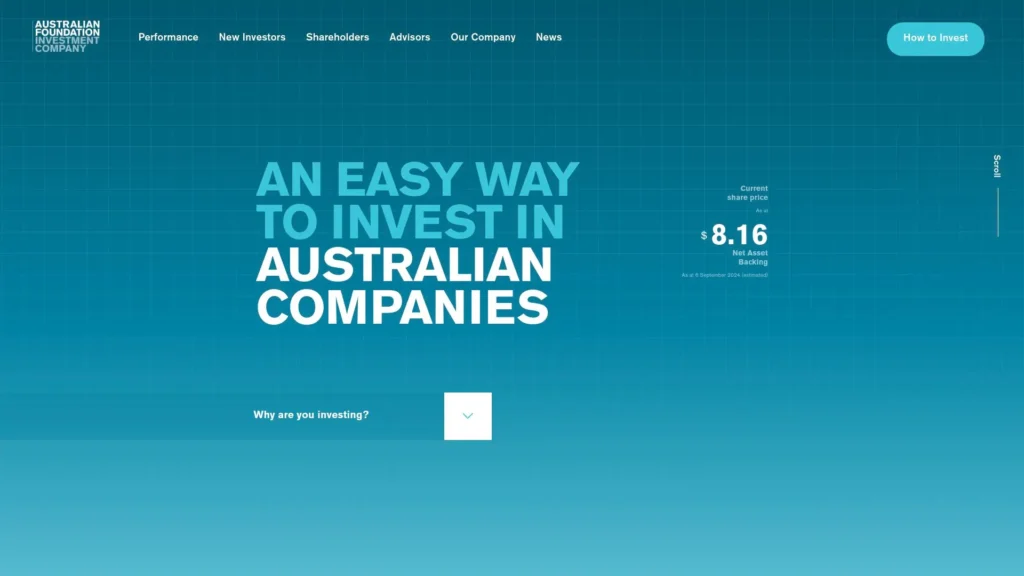
AFI is a long-standing LIC on the ASX with a history of fully-franked dividends.
Features
AFI offers a diverse portfolio of around 80-100 companies across different industries. They also have a dividend focus which means they deliver fully-franked dividends every year. Their long history of success in this regard brings a lot of peace of mind. Additionally, AFI keeps management costs low, which I appreciate. It means more of my money stays in my pocket.
The Dividend Substitution Share Plan is also worth noting, which can be a tax-efficient tool for those in need.
Pros
- Consistent track record of fully franked dividends
- Low management costs
- Diversified portfolio of blue-chip Australian stocks
- Long-standing reputation and experienced management team
- Often trades close to its Net Asset Value (NAV)
Cons
- May underperform in growth-focused markets
- Limited exposure to international markets
- Conservative approach may not appeal to aggressive investors
- Large size may limit flexibility in investment choices
Criteria Evaluation
- Investment Strategy: 4/5
- Performance History: 4/5
- Discount/Premium to NAV: 4/5
- Dividend Yield and Franking: 5/5
- Management Fees: 5/5
- Size and Liquidity: 5/5
- Track Record of Management Team: 5/5
Community Reviews and Expert Recommendations
Overall, AFI enjoys positive reviews from users and experts.
“I love AFI. All time high? Yes. Still an excellent long term opportunity? Yes. Buy now to sell soon in 12-24 months? No. Buy and hold for the foreseeable future? Sure! If it goes up, Hallelujah! If it goes down, wait for it to dip enough and buy more – Hallelujah! It’s a buy and hold forever for me.” – SiimplStudio via Reddit
Overall, users appreciate AFI’s reliability and ability to diversify a portfolio based on less risk. Experts agree with this and also highlight this LIC’s long history and proven track record.
Price
AFI’s share price varies, so it’s best to check the current market price. Remember, LICs can trade at a premium or discount to their Net Asset Value (NAV).
2. Argo Investments (ARG)
Best Known for: Diversified Portfolio and Low Costs
Next, I assessed Argo Investments, or ARG. This is one of the more solid, reliable LICs, and it’s been around since 1946. Throughout this time, ARG have focused on diversity, spreading their investments across many Australian companies. Of course, the aim is to bring consistent returns and dividends for shareholders.
The one thing that stuck out to me was how simple ARG’s approach is. It’s an ideal option for beginners because there’s no fancy or complicated strategies. It’s also a very cost-effective option.
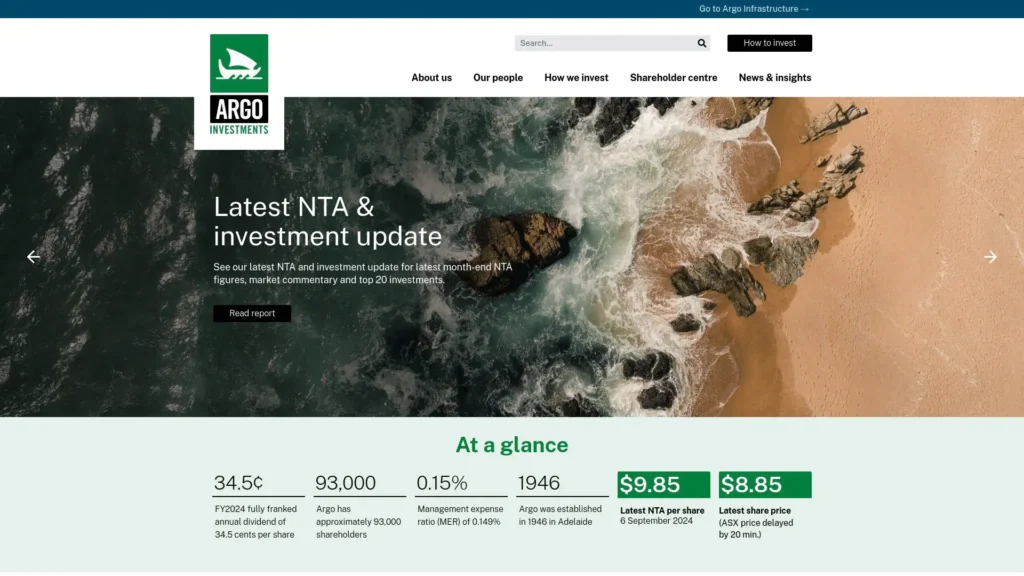
Argo Investments is one of Australia’s largest LICs on the ASX.
Features
Like many LICs, Argo offers a diversified portfolio across blue chip companies, mid-caps, and small-caps. They also offer fully-franked dividends and low costs within all of this. Management expense ratio is particularly low, which means more dividends remain in my pocket. They also offer a Dividend Reinvestment Plan. This allows me to reinvest my dividends and buy more shares without paying a brokerage fee. I’d recommend this option for anyone who wants to push their investing further.
Pros
- Highly diversified portfolio of Australian companies
- Consistent track record of fully franked dividends
- Very low management costs
- Long-standing reputation and experienced management team
- Generally trades close to its Net Asset Value (NAV)
Cons
- Limited exposure to international markets
- May underperform in periods of rapid market growth
- Conservative approach may not appeal to aggressive investors
- Large size may limit flexibility in investment choices
Criteria Evaluation
- Investment Strategy: 4/5
- Performance History: 4/5
- Discount/Premium to NAV: 4/5
- Dividend Yield and Franking: 5/5
- Management Fees: 5/5
- Size and Liquidity: 5/5
- Track Record of Management Team: 5/5
Community Reviews and Expert Recommendations
Overall, Argo Investments enjoys relatively positive reviews from users. Most state that they appreciate the long-term history of the company, as it brings peace of mind. Additionally, many users mention the low fees and fully-franked dividends.
Industry experts praise Argo for its long-history and also its dividend reinvestment plan.
Price
ARG’s share price fluctuates, so it’s best to check the current market price.
3. WAM Capital (WAM)
Best Known for: Active Management in Small-Mid Caps
WAM Capital is a popular ASX-listed LIC. However, it’s not quite as calm and reliable as the other two LICs I’ve reviewed so far. This LIC has an active management focus on undervalued growth companies in the small to mid-cap area. Put simply, they’re always looking for the next big thing. This means there is a chance of higher returns but it’s like investing in the wild west; you just don’t know.
With an active management approach, WAM comes with higher risk, but potentially higher rewards. I’d recommend this LIC for those who aren’t quite as risk-averse.
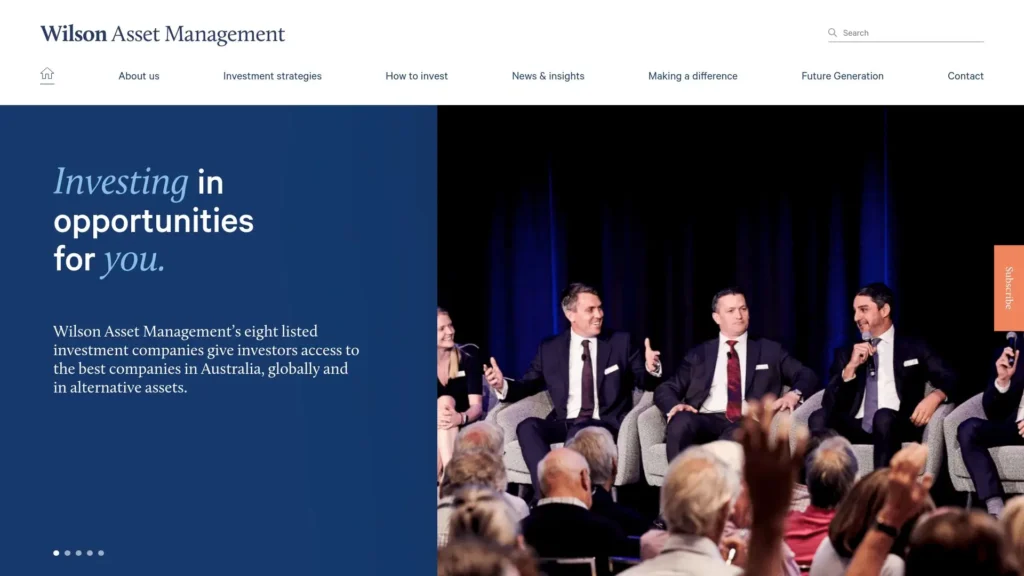
WAM has an active management approach to investing and among the top LICs on the ASX.
Features
The first main feature to mention is WAM’s active management approach; something I’ve touched upon already. This LIC has a proactive stance on investment, looking for new opportunities all the time. The fact they focus on small to mid-cap companies does bring extra risk, but also the chance of higher gains.
Another strong feature is their research-driven investment process. They carefully analyse potential investments to ensure the best opportunities. Additionally, WAM has consistent payouts of fully-franked dividends.
Pros
- Potential for higher returns through active management
- Focus on undervalued growth companies in small-mid cap space
- Strong track record in outperforming during certain market conditions
- Regular fully franked dividends
- Experienced management team led by Geoff Wilson
Cons
- Higher volatility compared to more conservative LICs
- Higher management fees due to active strategy
- Can trade at a premium to NAV, potentially reducing value
- Performance can be inconsistent, with periods of underperformance
- May not suit investors seeking a steady, low-risk approach
Criteria Evaluation
- Investment Strategy: 4/5
- Performance History: 4/5
- Discount/Premium to NAV: 3/5
- Dividend Yield and Franking: 4/5
- Management Fees: 3/5
- Size and Liquidity: 4/5
- Track Record of Management Team: 5/5
Community Reviews and Expert Recommendations
WAM has a mixed bag of reviews from users. While many appreciate the opportunity to earn higher dividends, this does come with additional risk. Many users are happy to accept this, but it can be a rollercoaster ride for those who aren’t. A problematic point some users mention is the high fees.
So, while WAM offers the chance of bigger returns, it does come at a cost. It’s not the best option for anyone who prefers solid investments. Experts also agree with this idea. While they appreciate WAM’s focus on analysis, they don’t recommend this LIC for beginners or risk-averse investors.
Price
WAM’s share price fluctuates and often trades at a premium to its NAV.
4. MCP Master Income Trust (MXT)
Best Known for: Corporate Loan Market Exposure
The next LIC I looked at was MCP Master Income Trust, or MXT. This option has a different approach to the other LICs I’ve looked at so far. Rather than buying shares in companies, it lends money instead. Offering corporate loans might sound like an odd strategy but MXT has been around since 2010, so it’s certainly working.
Overall, MXT offers me a great opportunity to diversify my portfolio. While it doesn’t have the entertainment factor of WAM, it offers a more reliable route and offers monthly payments. In many ways, it’s another form of passive income.
However, there are some risks because the corporate loan market can be difficult during economic downturns.
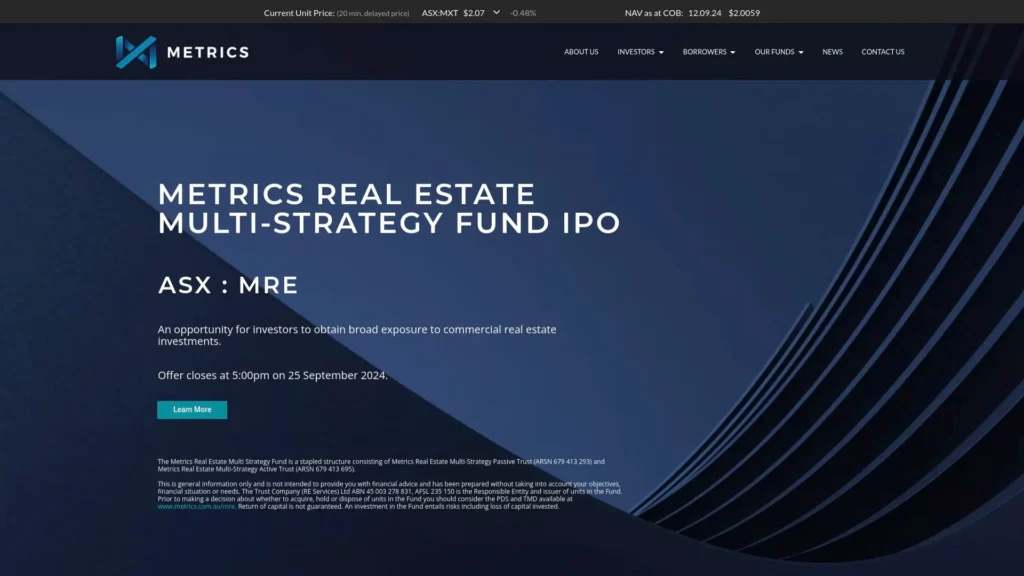
As one of the top LICs on the ASX, MXT works by offering corporate loans and paying monthly dividends.
Features
As I’ve mentioned, MXT offers corporate loans, lending money to companies and collecting interest. Personally, I think the best thing about MXT is that it pays out monthly dividends, so I can easily see my returns much faster.
This LIC also has an active management approach, constantly assessing and managing their options. Again, that means I can diversify my portfolio, increase gains, and minimise risk.
The other point to mention is that MXT’s loans are usually floating rate. So, if the interest rates increase, so do their returns.
Pros
- Exposure to corporate loan market, providing portfolio diversification
- Monthly income distributions
- Potential for higher yields compared to traditional fixed income investments
- Active management by experienced team
- Floating rate loans may benefit from rising interest rates
Cons
- Higher risk compared to government bonds or term deposits
- Performance can be impacted by economic downturns
- More complex investment strategy may be harder for some investors to understand
- Limited capital growth potential compared to equity investments
- Relatively higher fees compared to passive investment options
Criteria Evaluation
- Investment Strategy: 4/5
- Performance History: 4/5
- Discount/Premium to NAV: 4/5
- Dividend Yield and Franking: 5/5
- Management Fees: 3/5
- Size and Liquidity: 4/5
- Track Record of Management Team: 4/5
Community Reviews and Expert Recommendations
Most users have one main area of praise for MXT, and that’s the monthly payments. Additionally, users also feel that this LIC is a good option for portfolio diversification beyond traditional bonds and equities. The biggest downside is slightly higher fees than an average LIC, however the monthly payments almost make up for it.
Experts agree with the usefulness of monthly dividends. However they also mention that market volatility and economic issues can increase risk.
Price
MXT’s unit price can fluctuate and can be slightly higher than some other LICs However, it generally trades close to its Net Asset Value (NAV).
5. BKI Investment Company (BKI)
Best Known for: Focus on Dividend-Paying Companies
I tested BKI Investment Company next and discovered that it stands out for a reason. This LIC focuses on companies with strong dividend histories, identifying those that are likely to be more profitable for its investors. For that reason, I appreciate this LIC for its ability to pay a steady stream of dividends.
Another thing I appreciate about this LIC is its low-cost construction. However, it’s not the best fit for anyone who enjoys the excitement of high-risk investing. In this case, dividends are regular, but it’s a tradeoff between this and potential growth limitations.
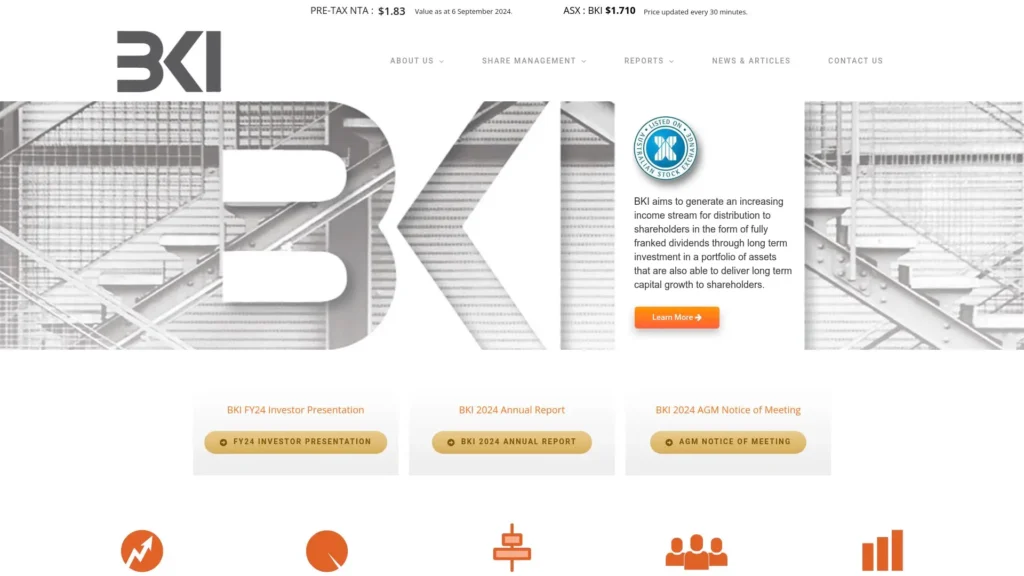
BKI is a unique LIC focusing on companies with strong dividend histories.
Features
Although LIC isn’t as high-octane in terms of investing excitement, it still has plenty of features. First, we know it focuses on dividend-paying companies. That’s ideal because it means a steady stream of returns. Another plus point is its strong diversification across many sectors and companies. This reduces risk and, again, increases the potential for gains.
I also found that BKI’s management expense ratio is relatively low compared to other LICs, which is another boon for cost-saving. Additionally, dividends are fully-franked.
Finally, this LIC has ties to the Millner family, which is a heavyweight in the Australian investing world.
Pros
- Strong focus on companies with consistent dividend histories
- Low management costs
- Diversified portfolio across various sectors
- Track record of providing fully franked dividends
- Experienced management team with strong reputation
Cons
- May underperform in growth-focused markets
- Limited exposure to high-growth sectors
- Conservative approach may not appeal to aggressive investors
- Potential for lower capital growth compared to growth-focused LICs
Criteria Evaluation
- Investment Strategy: 4/5
- Performance History: 4/5
- Discount/Premium to NAV: 4/5
- Dividend Yield and Franking: 5/5
- Management Fees: 5/5
- Size and Liquidity: 4/5
- Track Record of Management Team: 4/5
Community Reviews and Expert Recommendations
Most users rate BKI quite highly, although they appreciate that it’s not going to raise anyone’s heart rate. For most, that’s more than fine, especially when regular dividend payments are rolling in. Most users especially appreciate diversification, which reduces risk.
Experts agree BKI is a solid choice. However, they mention that it may not be a good choice for investors looking for aggressive growth or exposure to emerging sectors.
Price
BKI’s share price fluctuates, but it often trades close to its Net Asset Value (NAV).
6. Tribeca Global Natural Resources Limited (TGF)
Best Known for: Exposure to Global Natural Resources
Tribeca Global Natural Resources Limited, or TGF, is one of the most distinctive LICs. In this case, it deals in the global natural resources sector, including energy, agriculture, and mining.
When I first watched TGF, I had my doubts. These sectors aren’t known for their reliability, however TGF has a good reputation and it’s always looking for new opportunities. Again, this LIC has an active management approach. However, it isn’t a great option for anyone who doesn’t like risk. It’s a good choice for anyone who doesn’t mind unpredictability, and those who believe in the long-term potential of natural resources.
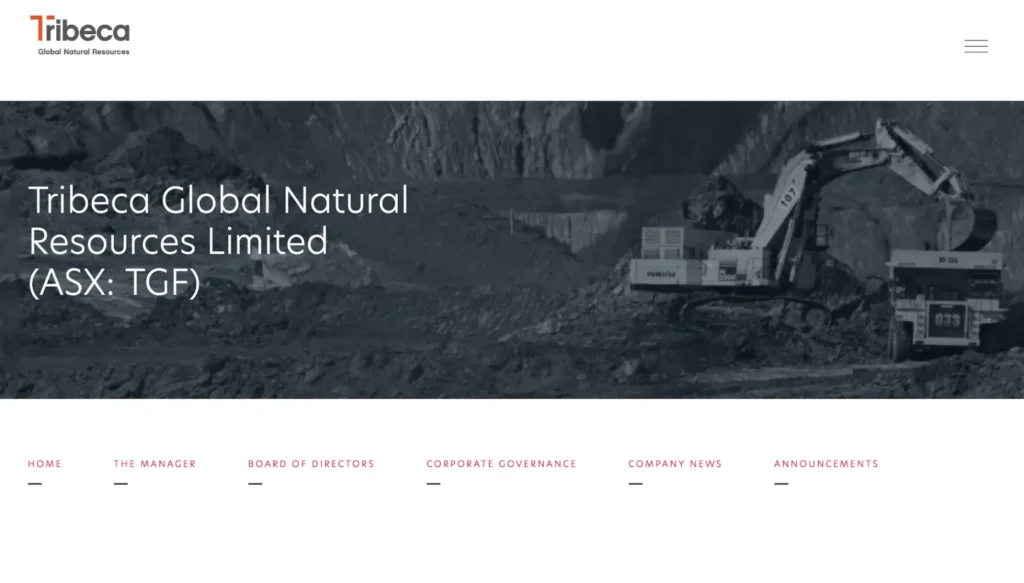
TGF covers the global natural resources sector as one of the best LICs on the ASX.
Features
We know TGF focuses on the global natural resources sector. That means they aren’t diversifying their approach too much. However, their active management approach means they’re always looking for new opportunities within those areas. This approach also means they regularly analyse and strategise – they simply don’t miss a trick.
Another feature I find useful is this LIC’s global reach. They don’t only focus on Australian opportunities, which increases the chances for gains. Additionally, there are different investment instruments available, including commodities, stocks, and bonds.
A final plus point to mention is that TGF often trades at a discount to its Net Asset Value, or NAV. While it won’t save a huge amount of money, it’s still less than it would otherwise be.
Pros
- Exposure to global natural resources sector
- Active management by experienced team
- Potential for high returns during resource booms
- Flexibility in investment types
- Often trades at a discount to NAV
Cons
- High volatility due to sector focus
- Performance can be heavily influenced by commodity prices
- Higher risk compared to more diversified LICs
- Can underperform significantly during resource downturns
Criteria Evaluation
- Investment Strategy: 3/5
- Performance History: 3/5
- Discount/Premium to NAV: 4/5
- Dividend Yield and Franking: 3/5
- Management Fees: 3/5
- Size and Liquidity: 3/5
- Track Record of Management Team: 4/5
Community Reviews and Expert Recommendations
TGF has a mixed bag of reviews, but overall they are quite positive. Users appreciate the regular dividends but do realise that is some uncertainty in these sectors. The discount to NAV is another positive point that many mention, and ease of use.
Industry experts particularly rate TGF for its specialisation, but again, mention that it can be a higher risk. They also praise active management analytics for finding new opportunities.
Price
TGF’s share price can be quite volatile due to its sector focus. It often trades at a discount to its Net Asset Value (NAV), but this can change quickly. Always check the current market price and compare it to the latest reported NAV before investing.
7. Platinum Asset Management (PTM)
Best Known for: Contrarian Global Investing Approach
Platinum Asset Management, or PTM, focus on global equities but they tend to go against popular approaches. Rather than going for common opportunities, instead they look for overlooked ones. This is obviously a risk, but it also creates the chance for greater gains.
This contrarian approach caught my eye while reviewing this LIC and I can appreciate why it’s a popular choice. Going against the crowd is certainly intriguing, and within that, they have a global reach.
Of course, this approach does come with a greater chance of dips in performance, more so than other LICs. However, that’s the nature of this type of investment. For anyone who enjoys a smooth investment process, this might not be an ideal option. However, those who don’t mind a little risk for the chance of greater dividends may enjoy PTM.
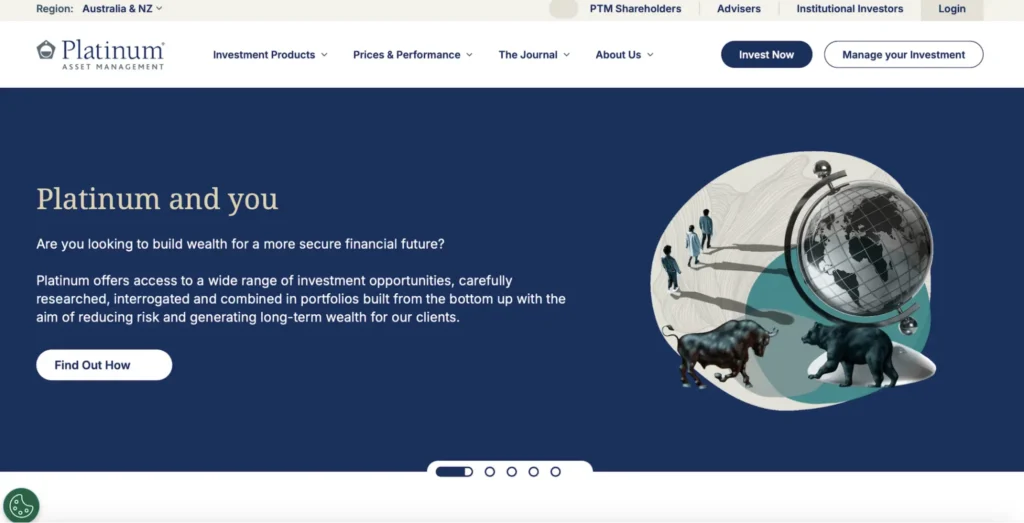
Platinum Asset Management (PTM) has a contrarian approach to investing as one of the best LICs on the ASX.
Features
The main point that stands out about PTM is its approach to global investing. I’ve already mentioned that it goes against the crowd to find unique opportunities. The perk here is that I can find investments that may bring bigger gains before they become extremely popular. The global aspect is also positive, creating a larger pool to dip into.
Another key feature of this LIC is its in-depth research process. PTM really digs into potential investments to understand their pros and cons. They really understand the markets they’re working with.
In the past, PTM has also been known to take short positions in overvalued companies. They’re willing to take a little risk to reach greater gains, which can be transferred to customers. So, while it’s risky, it does have the opportunity for big dividends.
Pros
- Global diversification across various markets and sectors
- Contrarian approach can lead to unique investment opportunities
- Strong research capabilities and on-the-ground presence in key markets
- Flexibility to hold cash and take short positions
- Potential for outperformance in certain market conditions
Cons
- Performance can be volatile and may underperform in momentum-driven markets
- Contrarian approach can lead to extended periods of underperformance
- Higher fees compared to passive global equity funds
- Currency fluctuations can impact returns for Australian investors
- Complex investment strategy may be difficult for some investors to understand
Criteria Evaluation
- Investment Strategy: 4/5
- Performance History: 4/5
- Discount/Premium to NAV: 4/5
- Dividend Yield and Franking: 3/5
- Management Fees: 3/5
- Size and Liquidity: 4/5
- Track Record of Management Team: 5/5
Community Reviews and Expert Recommendations
PTM’s community reviews are a mixed bag, however most users rate this LIC for its potential to bring greater dividends. Most appreciate that with this type of investment, there is a large amount of risk. Some users are happy with that, others aren’t. For that reason, it’s vital to assess investment goals before jumping in.
Global reach is another common mention, offering more opportunities within a year.
Industry experts agree that PTM does have potential for larger gains, however they mention that a contrarian approach can be extremely risky.
Price
PTM’s share price can fluctuate based on both their investment performance and market sentiment towards their contrarian approach. For that reason, always check the current market price and compare it to the latest reported Net Asset Value (NAV).
8. Forager Australian Shares Fund (FOR)
Best Known for: Value Investing in Australian Small-Mid Caps
The final LIC I reviewed was Forager Australian Shares Fund, or FOR. This company looks to invest in the mid-cap space across Australia. This brings many opportunities for larger gains as they tend to avoid the bigger, blue chip options. It’s true that small to mid caps can be a riskier option and requires patience over the long-term. However, I appreciate this LIC’s approach and I can see how it could be a smart move.
I was interested to see that they have a concentrated portfolio approach and they don’t spread themselves too thin. Instead, they choose the best opportunities and focus on them.
Of course, this LIC isn’t for the risk averse, as this area of the market can be volatile. However, it’s a good choice for those who like LICs to evoke a little adrenalin.
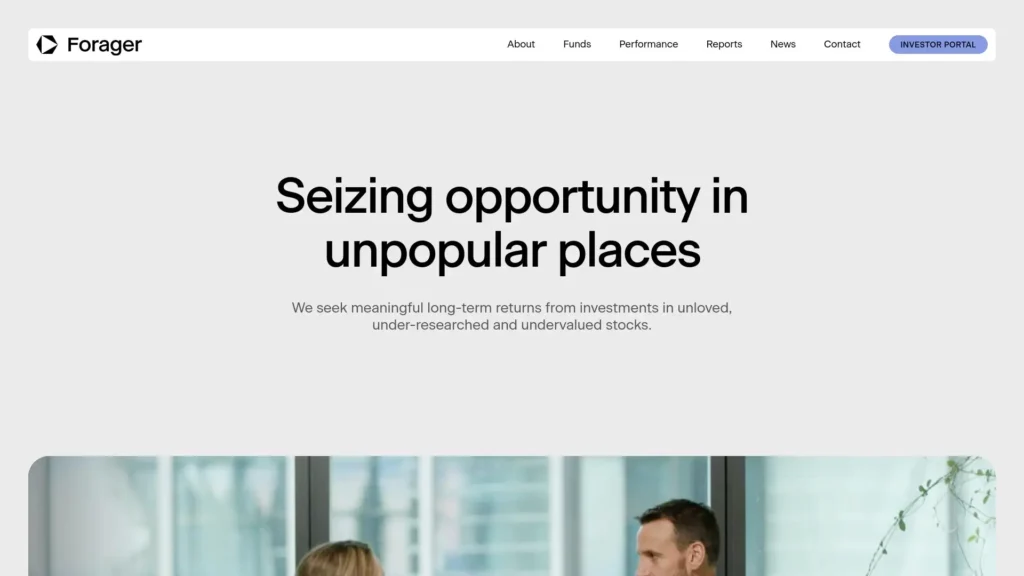
FOR focuses on small to mid cap investment opportunities as one of the top LICs on the ASX.
Features
This LIC’s main feature is its focus on the small to mid cap Australian space. They look for lesser-known companies and quality investments. In essence, they’re going against the crowd and carefully assessing opportunities. They aren’t scared to buy stocks that other companies are selling or hold cash when they can’t find opportunities. This unique approach has the potential for larger gains, although it is risky.
A key feature I really appreciate is FOR’s transparency. They are very open about their processes and holdings, which certainly gives extra peace of mind.
Moreover, a team that invests their own money alongside shareholders manages this FIC. Again, it’s about peace of mind.
Pros
- Focus on potentially undervalued small-mid cap companies
- Concentrated portfolio of high-conviction ideas
- Potential for high returns if value is realised
- Experienced team with a value investing focus
- Management co-investment aligns interests with shareholders
Cons
- Higher volatility due to small-mid cap focus
- Concentrated portfolio increases stock-specific risk
- Value approach can lead to extended periods of underperformance
- Smaller size may limit investment opportunities
- Higher fees compared to passive index funds
Criteria Evaluation
- Investment Strategy: 4/5
- Performance History: 4/5
- Discount/Premium to NAV: 4/5
- Dividend Yield and Franking: 3/5
- Management Fees: 3/5
- Size and Liquidity: 3/5
- Track Record of Management Team: 4/5
Community Reviews and Expert Recommendations
Most users enjoy the FOR investment process, though it can be risky. The careful analysis of different opportunities is something most users also highlight, and ease of use. The fact that Forager often focuses on market areas that larger funds overlook brings extra excitement to the process. However, risk averse investors often find this process a little too much for their liking.
Industry experts agree that FOR is a quality LIC and that it has the potential for significant gains. However, they also highlight the risk aspect and potential for periods of underperformance.
Price
FOR’s unit price can be quite volatile due to its small-mid cap focus and concentrated portfolio. It can trade at a discount or premium to its Net Asset Value (NAV), so it’s crucial to check the current market price and compare it to the latest reported NAV before investing.
Notable Mentions
If the eight LICs I’ve reviewed aren’t to your liking, here are a few others you might like to consider:
Hygrovest Ltd (HGV)
Having traded on the ASX since 2015, Hygrovest Ltd has a global focus. It offers regular dividend payments and a slightly less risk than some other LICs. This is due to its investment approach, focusing on lower risk opportunities.
Global Masters Fund (GFL)
Another notable mention is Global Masters Fund, or GFL. This is another quality LIC that was established in 2004. As a result, it’s got a good amount of reliability and a strong reputation. This is another LIC for those who don’t appreciate much risk.
Vanguard Australian Shares High Yield ETF (VHY)
Established more than 45 years ago, this is a name that is instantly recognisable and gives confidence. The idea here is low cost investments that have a good chance of yielding regular dividends. However, this isn’t an LIC that is likely to bring substantial gains due to its lower risk approach.
FAQ
What are the key factors to consider when choosing an LIC?
Before choosing an LIC, it’s important to think about investment goals. From there, look at performance history and fees as the first two elements. It’s also important to look at the premium or discount to Net Asset Value (NAV). Often LICs trade above or below the value of their underlying assets. If you can find one that gives a discount, it saves money.
Finding an LIC is a personal choice, but understanding your tolerable risk is another key aspect.
How do LICs differ from ETFs?
Both LICs and ETFS are ways to gain exposure to many different shares, however they are slightly different. LICs are actively managed, which means there are people behind the scenes making decisions about buying and selling. ETFs are usually passive, and typically track and index like the ASX 200.
Pricing is another key difference. LICs can trade a discount or a premium to their NAV (Net Asset Value). However, ETFs usually trade very close to their NAV.
Are LICs a good investment for beginners?
LICs can be a good investment for beginners, but it’s important to look carefully at different ones. There are some LICs that are riskier than others, so choosing carefully is vital.
LICs offer fast diversification, which is an ideal choice for new investors. Additionally, LICs focus on providing fully-franked dividends in a steady manner. This is great for generating passive income regularly. As for learning, many LICs also provide regular updates about their performance and holding. This is a good way to understand the investing world.
Despite the benefits, it’s important to do thorough research before investing. Check out our research on ETFs vs. LICs.
How often do LICs pay dividends?
LICs pay out their dividends differently, so it’s important to check before making a decision. Some do so monthly, which is very useful for passive income, whereas others pay out twice per year.
Of course, payment frequency shouldn’t be the only aspect to consider when choosing an LIC. It’s a good idea to look at other aspects and compare accordingly. Our resource on how dividends work with ETFs is a useful place to start.
Can LICs be held in a self-managed super fund (SMSF)?
It is possible for LICs to be held in a self-managed super fund, or SMSF. This is actually a good idea because LICs offer instant diversification. As such, you’re getting a mixture of different investments and reducing risk. Of course, it also means a steady stream of dividends.
It’s important to remember that different LICs have varying risk profiles. Some focus on blue-chip stocks and others on more volatile markets. Make sure that the choice you make aligns with your risk tolerance and investment goals.
For more information, check out our best SMSF investments guide.
Final Thoughts
Choosing an ASX-listed LIC is a time-consuming and confusing process at the start. However, with careful thought and research, it’s possible to reduce your choices down to the best option.
In this guide, I have reviewed the top eight listed investment companies on the ASX, and covered their pros and cons. While all have their upsides and downsides, it’s important to remember that there is no one-size-fits-all option. Everyone has their own risk tolerance level and investment goals. For that reason, it’s important to identify what these are before even considering LICs.
Remember that diversification is key, but checking fees is also a vital part of the puzzle. A key area where most beginner investors fall short is failing to check the discount or premium to NAV. It’s equally as important to look beyond dividends and toward the long-term picture.
Of course, I can’t finish this guide without mentioning online security. Online investments require inputting personal and financial data. Staying safe and secure is more vital than ever. Here at Privacy Australia, we offer a range of resources to help you do just that. From using VPNs and password protectors and more, we’re committed to helping you avoid malicious online threats and protect your digital sovereignty.
You Might Also Like:



